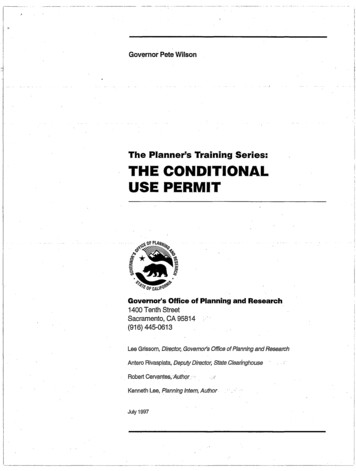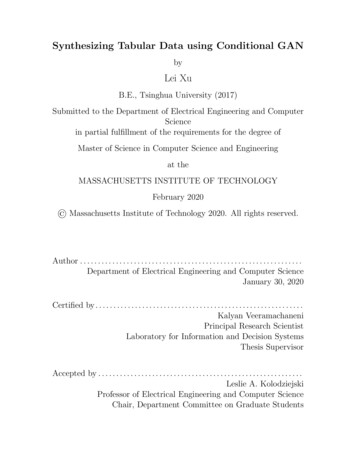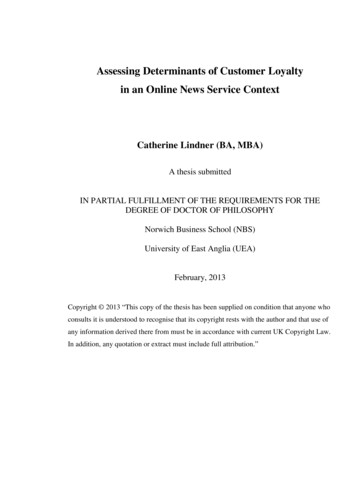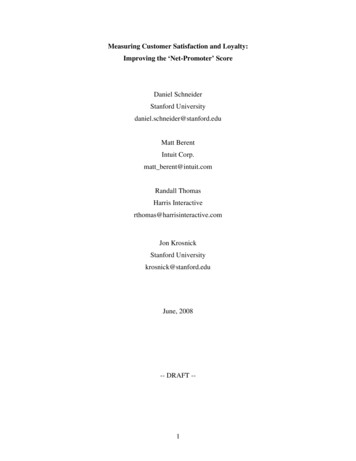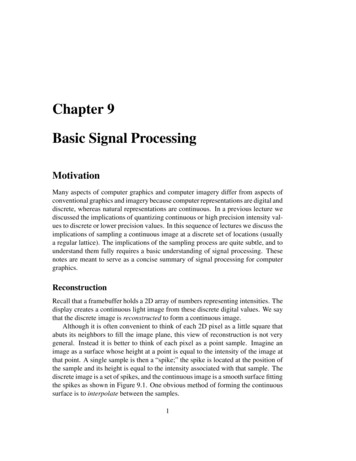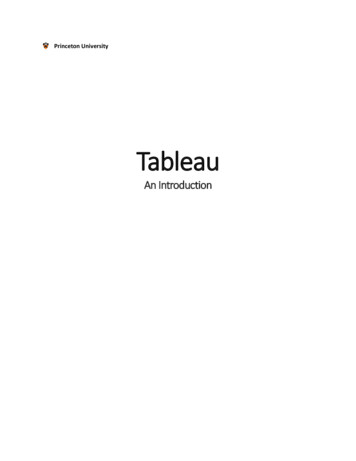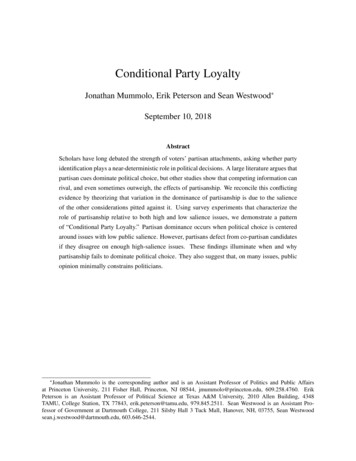
Transcription
Conditional Party LoyaltyJonathan Mummolo, Erik Peterson and Sean Westwood September 10, 2018AbstractScholars have long debated the strength of voters’ partisan attachments, asking whether partyidentification plays a near-deterministic role in political decisions. A large literature argues thatpartisan cues dominate political choice, but other studies show that competing information canrival, and even sometimes outweigh, the effects of partisanship. We reconcile this conflictingevidence by theorizing that variation in the dominance of partisanship is due to the salienceof the other considerations pitted against it. Using survey experiments that characterize therole of partisanship relative to both high and low salience issues, we demonstrate a patternof “Conditional Party Loyalty.” Partisan dominance occurs when political choice is centeredaround issues with low public salience. However, partisans defect from co-partisan candidatesif they disagree on enough high-salience issues. These findings illuminate when and whypartisanship fails to dominate political choice. They also suggest that, on many issues, publicopinion minimally constrains politicians. Jonathan Mummolo is the corresponding author and is an Assistant Professor of Politics and Public Affairsat Princeton University, 211 Fisher Hall, Princeton, NJ 08544, jmummolo@princeton.edu, 609.258.4760. ErikPeterson is an Assistant Professor of Political Science at Texas A&M University, 2010 Allen Building, 4348TAMU, College Station, TX 77843, erik.peterson@tamu.edu, 979.845.2511. Sean Westwood is an Assistant Professor of Government at Dartmouth College, 211 Silsby Hall 3 Tuck Mall, Hanover, NH, 03755, Sean Westwoodsean.j.westwood@dartmouth.edu, 603.646-2544.
Partisanship serves as the preeminent cue voters use to navigate politics—it offers a powerfulheuristic that shapes candidate choice, opinion toward policy proposals and even perceptions ofsocial conditions in the mass public. For decades, scholars of American Politics have debatedboth the empirical strength and normative implications of voters’ partisan attachments, askingwhether—in an increasingly polarized context—party identification plays a near-deterministic rolein how voters make decisions (e.g., Campbell et al., 1960; Bartels, 2000; Cohen, 2003)Despite scholarly agreement that partisanship serves as the central cue voters use to navigatepolitics, a long-standing and unresolved debate centers on the strength of partisan attachments.Pioneering studies offers evidence that partisanship dominates political choice (Campbell et al.,1960). These studies show that voters select co-partisan candidates at high rates (Bartels, 2000),respond less to other information when party labels are available (Rahn, 1993) and depend onpartisan cues, rather than ideological principles, to evaluate policy (Zaller, 1992; Cohen, 2003).However, these accounts of partisan dominance are inconsistent with some contemporary evidence.Experimental studies demonstrate that competing considerations can rival, and even exceed, theeffect of party labels on political decisions (Malhotra and Kuo, 2008; Boudreau and MacKenzie,2014; Bullock, 2011; Nicholson, 2011; Arceneaux, 2008). And even in an increasingly polarizedpolitical context, close to 10% of partisan voters in recent American National Election Studies(ANES) opposed their co-partisan presidential candidate—defections that are linked to issue-baseddisagreement with their party’s nominee (Gooch and Huber, 2018; Fowler, 2018; Rogers, 2017;Jessee, 2012).In this paper, we reconcile this conflicting evidence by developing a theory of “ConditionalParty Loyalty.” We theorize that variation in the prominence of partisanship in political decisionmaking is explained by the salience of the other considerations pitted against it. While patternsof partisan dominance occur when political choice is centered around issues with low publicsalience—i.e., issues that, while potentially policy relevant, are not top-of-mind for voters whenevaluating candidates—issue-based disagreement with their party’s nominee on enough high-salienceissues can compel partisans to defect to an out-party candidate.1
We focus on one important manifestation of party loyalty, an individual’s tendency to preferco-partisan candidates for office. We then test our theory of conditional party loyalty using conjointsurvey experiments that evaluate the relative contributions made by partisan cues and policy positions to candidate choice. In assessing the conditional nature of this relationship, these new studiesovercome several methodological challenges that limit the ability of prior research to speak to thisquestion. We first differentiate high and low salience issues using experimental pre-tests that identify the issues most consequential in this specific choice setting. This direct, behavioral assessmentof choice-specific issue salience avoids concerns about measurement error present in self-reportedor indirect measures of issue salience. Having empirically validated this issue typology, we thenuse paired-choice candidate conjoint experiments (Hainmueller, Hopkins, and Yamamoto, 2014)to evaluate the relative influence of a candidate’s positions on these issues, as well as their partylabel, for candidate choice. Finally, we measure a participant’s policy preferences for each issue,allowing us to measure when they oppose a candidate’s issue position.Our results explain when and why partisans are willing to defect from the party line. Whilesharing a party label with a candidate remains the single largest determinant of vote choice in thesestudies, voter loyalty is not inexhaustible and public opinion remains responsive to other considerations. Voters show strong allegiance to their party when selecting which candidates to support,but will defect from the party line if candidates diverge from the voter on enough high-salienceissues. At the same time, even disagreement with the voter on several low-salience political issuesfails to offset the gain in support a candidate receives from a shared party label, a pattern consistentwith prior studies that show the dominance of partisanship over public opinion.Beyond offering an explanation that synthesizes a mixed body of prior evidence, these findingsmake two important amendments to prior studies of how partisanship affects public opinion. First,in contrast to accounts in which the availability of party labels leads citizens to completely ignoreother choice-relevant attributes (e.g., Cohen, 2003; Rahn, 1993), we show that public opinion remains responsive in the presence of party labels, in the sense that even low-salience political issuesexert a small effect on candidate choice. Second, we offer a crucial supplement to recent studies2
demonstrating that other information can sometimes rival the effects of party labels (e.g., Bullock,2011; Nicholson, 2011; Boudreau and MacKenzie, 2014; Mullinix, 2016). Here we show that evenon a set of political issues where public opinion is highly responsive to policy considerations, votersare ultimately still more likely than not to support a co-partisan in a general election-style contestuntil the point at which they disagree with them on four or more high-salience issues. Politiciansreceive even greater latitude from their co-partisans on a host of issues with a lower degree of public salience, including trade policy, education standards and access to birth control. This suggeststhat in many areas with important policy implications, public opinion only minimally constrainspoliticians.The Role of Partisanship in Political DecisionsThe public often depends on expert cues to engage with politics (Downs, 1957; Schattschneider,1960; Sniderman, Brody, and Tetlock, 1991; Lupia, 1994). A candidate’s partisanship representsa particularly wide-ranging heuristic for simplifying complex decisions (Downs, 1957; Popkin,1991; Snyder and Ting, 2002). While party labels convey useful information, the public’s heavydependence on them also raises concerns. If politicians can support whichever political causes theyplease and still receive support from co-partisans, these cues arguably pose a significant obstaclefor representative governance (Achen and Bartels, 2016; Lenz, 2012; Zaller, 1992). In contrast, ifdivergence from public preferences on a certain set of issue positions results in substantial lossesin electoral support, partisan cues, while formidable, may not threaten democratic accountabilityto the extent some have theorized (Gerber and Green, 1999; Lavine, Johnston, and Steenbergen,2012; Arceneaux and Wielen, 2017). This tension underlies two lines of research that offer fundamentally different characterizations of what partisanship means for democratic accountability.Perspective 1: Partisan DominanceA large body of research argues that partisanship—in the form of a candidate’s party label ora partisan endorsement that accompanies a policy proposal—dominates public opinion (Campbellet al., 1960; Zaller, 1992). In the presence of partisan cues, the politically sophisticated engage in“partisan motivated reasoning” and interpret information so as to bolster their partisan attachments3
(Lodge and Taber, 2013; Bolsen, Druckman, and Cook, 2014). Their less sophisticated counterparts use partisanship as a heuristic to avoid processing political information, leading them tosupport co-partisan politicians and conform to their policy views (Popkin, 1991; ?; Riggle, 1992;Rahn, 1993; Kam, 2005). The combination of these processes produces substantial partisan influence over public opinion. The availability of party labels reduces the importance of other criteriafor political choice (Rahn, 1993) and results in partisanship receiving a greater weight than otherconsiderations when voters make decisions (Cohen, 2003).An array of observational evidence is consistent with this perspective. In cross-sectional surveys, partisanship is more predictive of candidate support than an individual’s ideology (Campbellet al., 1960; Bartels, 2000; Kinder and Kalmoe, 2017). Relatedly, when partisans hold issue positions at odds with their preferred candidate or political party, they often shift these views to bringthem into alignment with their partisan attachments (Lenz, 2012; Levendusky, 2009; Zaller, 1992).Some experimental evidence is also supportive. With respect to candidate choice, Rahn (1993)finds that introducing party labels into an experiment reduces consideration of a candidate’s othercharacteristics (see also, Lavine, Johnston, and Steenbergen, 2012; Kirkland and Coppock, 2018).Cohen (2003) experimentally varies a policy proposal’s content and the partisan endorsement itreceives and finds that partisanship overwhelms content in determining support. These patternsof partisan dominance are especially pronounced in the state of heightened elite polarization thatcharacterize contemporary American politics. More consistent party cues produce larger effects onthe preferences of party supporters (Levendusky, 2010; Bolsen, Druckman, and Cook, 2014) andcrowd out the influence of policy considerations (Druckman, Peterson, and Slothuus, 2013). Thereis also evidence that emotions tied to civic participation are more strongly activated by partisanidentity than issue-based concerns. Huddy, Mason, and Aarøe (2015) shows that threatening strongpartisans with electoral losses evokes stronger emotional reactions than among those who holdideologically consistent views, which may in turn foster electoral engagement. Similarly, Mason(2015) argues that mass polarization is caused by sorting that has strengthened partisanship as asocial identity, not by issue disagreement between the parties.4
This evidence inverts views of democratic accountability in which public opinion serves as aconstraint on political elites (e.g., Dahl, 1971). It reveals a number of instances in which publicopinion follows from the viewpoints of co-partisan politicians, leaving these officials with “considerable freedom in the policies they choose” (Lenz, 2012, 235). Moreover, the manner in whichpartisanship induces non-responsiveness to other considerations is worrisome as “people tend toadopt beliefs, attitudes, and values that reinforce and rationalize their partisan loyalties” (Achenand Bartels, 2016, 296). Even for accounts that portray partisan cues as a useful heuristic, theprevalence of cue-taking present in these studies is problematic as the public follows partisan cueseven when they may be a poor source of guidance (e.g., Downs 1957, 233-234; Lupia and McCubbins 1998, 206-208; Hochschild 2012, 532-534; Kuklinski and Quirk 2000).Perspective 2: Continued Responsiveness Despite PartisanshipWhile the preceding work gives partisanship a privileged role in information processing, analternative perspective is that partisan cues are simply one more, albeit influential, piece of information individuals incorporate into their political judgments even as they remain responsive toother considerations (Green, Palmquist, and Schickler, 2002; Fiorina, 1981; Downs, 1957). Whenpartisanship conflicts with an individual’s other preferences (e.g., their policy views), these othercriteria can still compel them to oppose candidates and policy proposals that share their party label, although elite-level candidate selection and the anticipatory actions of politicians may limitopportunities for this to occur during campaigns (e.g., Fowler, 2018; Zaller, 2012; Lenz, 2012).A number of recent studies are inconsistent with the canonical accounts of partisan dominancedetailed in perspective 1, showing that, while party labels exert a strong influence on politicaldecisions, they do not blind individuals to other relevant attributes. In several experiments thatvary the availability of partisan cues and other information (e.g., policy content, expert evaluations), individuals incorporate these other considerations to the same extent whether or not partisan cues are available (Malhotra and Kuo, 2008; Tomz and Houweling, 2009; Nicholson, 2011,2012; Boudreau and MacKenzie, 2014). The effects of these other choice attributes rival, and attimes exceed, the role of partisanship in political decisions (Riggle et al., 1992; Arceneaux, 2008;5
Bullock, 2011; Sniderman and Stiglitz, 2012; Boudreau and MacKenzie, 2018; Boudreau, Elmendorf, and MacKenzie, ND). As more relevant information about a candidate beyond their partylabel becomes available, the effects of partisanship on political decision-making diminish (Peterson, 2017). Observational studies also reveal instances in which moderate electorates penalizeideologically extreme politicians (Hall, 2015; Canes-Wrone, Brady, and Cogan, 2002) and voters fail to support co-partisan candidates who diverge from their issue preferences (Ansolabehere,Rodden, and Snyder, 2006; Ansolabehere and Jones, 2010; Jessee, 2012). There is also evidencethat other aspects of voters’ social identities can mute partisan concerns in some settings (Levendusky, 2018). For example, Klar (2013) shows that among Democrats, priming concerns relevantto parenting can cause sharp reductions in support for traditional Democratic policies.A Theory of Conditional Partisan LoyaltyRather than stipulate the appropriateness of a single perspective on partisan cues, we insteadoffer an explanation for when accounts of partisan dominance over public opinion do and do notapply. What explains this variation in the role of partisanship in political choice? Our argumentis simple: the dominance of partisanship in political decision-making depends on the salience ofthe considerations that are counter-posed against it. In this case, we focus on the contribution of acandidate’s party label and issues positions to the assessments they receive from the public.We argue that the influence of party labels on candidate choice depends on the degree to whichvoters are cross-pressured by a candidate’s positions on highly salient issues: issues which polarizepartisans in the mass public and are thus the focus of contestation in campaigns and top-of-mind atthe ballot box. In situations where a voter’s preferred partisan candidate takes traditional positionson high-salience issues, partisan dominance is likely to occur. However, when partisanship is pittedagainst low-salience political issues, the relative influence of party labels will be less pronounced.A central implication of our theory is that persistent high rates of co-partisan voting in theU.S. are a product of a polarized candidate pool that almost always holds the party line on salientissues of the day. While these patterns make voters appear to be blind party loyalists, they areobservationally equivalent to a scenario in which voters simply have not been given a reason to6
defect to the out-party because candidates tend to take familiar issue stances (see also, Fowler,2018). However, Conditional Partisan Loyalty theory posits that voters’ allegiance to their partiesis finite, and that in the event candidates take divergent stances on key issues, the relative influenceof shared party labels will be diminished. At the same time, politicians should have much greaterdiscretion, more in line with prior accounts of partisan dominance over public opinion, when theytake positions on issues that fall below this degree of prominence.While straightforward, this attribute-focused explanation differs in important ways from priorresearch on factors that moderate the role of partisanship in public opinion which either focus onindividual personality differences (Arceneaux and Wielen, 2017; Lavine, Johnston, and Steenbergen, 2012; Kam, 2005) or contextual variation in the amount of available information (Bullock,2011). Instead, our theory centers on how the types of information competing against party labelsinfluence whether partisanship dominates political choice. This foregrounds a point that receiveslimited attention in the prior literature (Arceneaux, 2008; Ciuk and Yost, 2016 are notable exceptions).In the next section, we elaborate on the underpinnings of this theoretical perspective. We thendemonstrate how it helps to reconcile the conflicting bodies of evidence cited above, as well asotherwise anomalous within-study variation that has emerged in some prior work. Finally, we noteseveral issues that limit the ability of existing research to fully test this account, motivating thedesign of the new studies we employ here.What Can Partisanship Dominate?Conditional Partisan Loyalty theory argues that only highly salient information can offset theeffect of partisan cues—possibly to the point of inducing partisan defections. By “salient” we meaninformation that voters deem important and that is top-of-mind at the ballot box. We operationalizethis concept by focusing on political issues that sit at the center of core policy disagreements amongthe voting public. We contrast these important issues with low-salience pieces of information, bywhich we mean political issues that most individuals do not incorporate into their political decisions. We expect patterns of partisan dominance to occur in candidate choice when the influence7
of partisanship is considered relative to low-salience political issues.Our use of this distinction between high and low-salience political issues to understand variation in the relative contribution of party labels and issues to candidate choice builds on priorresearch that proposes a bifurcated role for policy issues in voting behavior. A core insight toemerge from this research is that there is substantial heterogeneity in the contribution that issuesmake to the public’s candidate assessments.At one end of the spectrum are political issues that broad segments of the public understand,consider important and bring to bear on their political judgments. These considerations receive avariety of labels in prior scholarship—“latent” opinions in Key (1961), “crystall
TAMU, College Station, TX 77843, erik.peterson@tamu.edu, 979.845.2511. Sean Westwood is an Assistant Pro- fessor of Government at Dartmouth College, 211 Silsby Hall 3 Tuck
